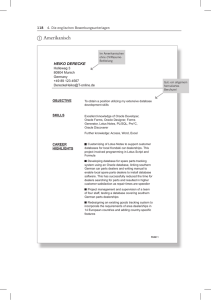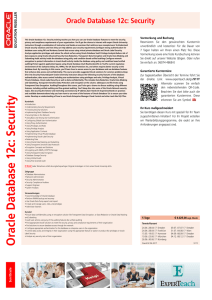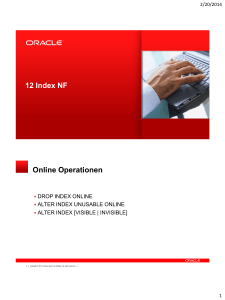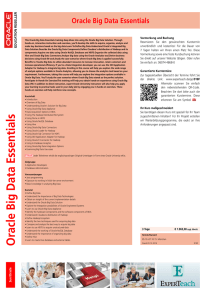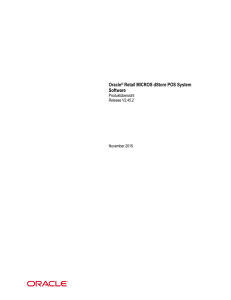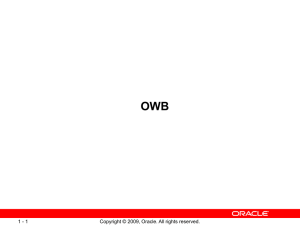How Mokia Uses Oracle Spatial to Create the NAVTEQ Map
Werbung
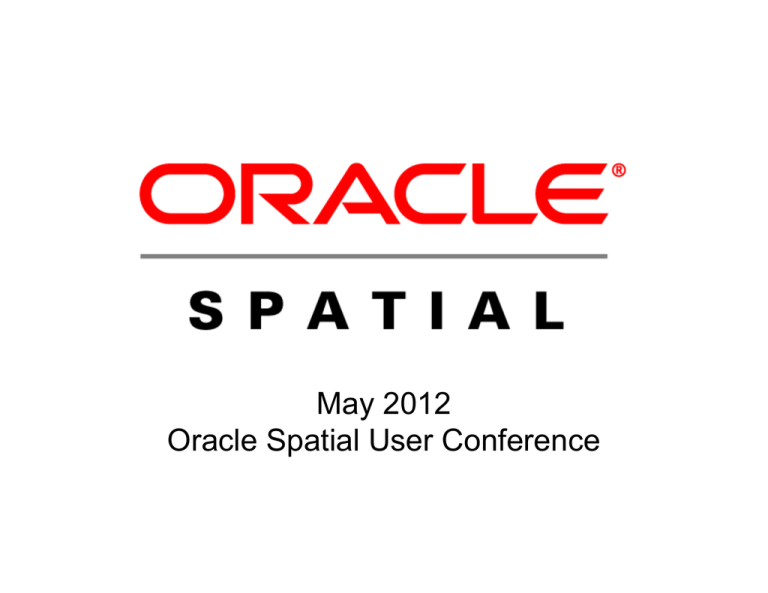
May 2012 Oracle Spatial User Conference 1 May 23, 2012 Ronald Reagan Building and International Trade Center Washington, DC USA Amit Ghosh Lead Architect, Nokia How Nokia Uses Oracle Spatial to Create the NAVTEQ Map Program Agenda • About Nokia Location & Commerce • The NAVTEQ Map • Map Specifications • Oracle Spatial 5 Nokia Location & Commerce Created to deliver differentiated location experiences Enabling a new range of opportunities to create products across multiple screens 6 Largest Commercial Map Provider High quality is our hallmark Con$nued Investment in the Map Resource Investing over €250M/ year 7 People +7000 employees globally Coverage Global with > 38 million KM roadway Nokia Location & Commerce Countries with NAVTEQ maps Countries with maps 2.4M map changes/ day 12K Cities with Natural Guidance 28 Places kilometers 8 of roadway Public transport cities geocoder requests daily 45 NAVTEQ True cars deployed 11B probe points processed monthly +19M point addresses 500+ search queries annually map tiles served daily countries with Traffic destination maps +1B 120M 75M 120M 1.8K 3D landmarks 38M 26 5 91 196 24M route requests per month 55M positioning requests daily >100M uses of the NAVTEQ Map every day Nokia L&C and Oracle Nokia and Oracle have been collaborating since 2001 • NAVTEQ map shipping in Oracle format for over a decade Nokia is the only turnkey provider of production global content for mapping, geocoding, and routing services for the Oracle stack • With unique add-ons such as point addressing, truck specific attributes for truck routing, and much more Nokia is not only the foremost provider of content for the Oracle platform… …we are Oracle Spatial users too! 9 Program Agenda • About Nokia Location & Commerce • The NAVTEQ Map • Map Specifications • Oracle Spatial 10 The NAVTEQ Map • 22 million miles of roads in 91 countries • 44 million points of interest • 80,000 data sources • Used in 85% + of all in-vehicle navigation systems • Portable Navigation Systems • Web based applications including Yahoo maps, Bing maps and Mapquest 11 • Smartphones Lumia apps: Nokia Maps, Nokia Drive, Nokia transport The NAVTEQ Map 1750+ analysts making 2.4 million changes daily. Collecting up to 260 attributes of the real world around us. Road Network Attributes: Street names Speed limits Number of lanes Functional class ( 5 Levels) Paved roads Access and exit roads Roundabouts Road sign text Intersection coding Postal Data: Postal codes House number ranges Administrative Data: Country State County City Restricted Driving Maneuvers: Access characteristics: autos, buses, taxis, emergency vehicles, deliveries, residents, pedestrians, car pools One ways No left/right turns Legal and physical dividers Gates Toll booths The NAVTEQ Map 44 million points of interest 50+ categories: Hotel chains Shopping Centers Gas stations Auto Repair Shops Restaurants Bus Stations Cuisine Golf Courses Banks Hospitals Airports Universities Tourist attractions Parks Cemeteries Woodlands 13 The NAVTEQ Map Applications: Industries: Telematics Automotive Location-Based Services Utilities Geomarketing Telecommunications Geographic Information Insurance Systems (GIS) Transport and Logistics Field Force Optimization Retail and Banking Call Center Emergency Services Resource Scheduling and Optimization Business Intelligence 14 Map Delivery Formats • SIF+ (ASCII) • GDF 3.0 (ASCII) • RDF (Relational) • NAVTEQ-ODF (Oracle Delivery Format) • NAVSTREETs ( GIS systems ) a) ESRI shapefile format b) MapInfo table format 15 Program Agenda • About Nokia Location & Commerce • The NAVTEQ Map • Map Specifications • Oracle Spatial 16 Map Specifications • Single worldwide specification with cartographic continuity across borders. • Permanent and unique identifiers for map objects. • WGS84 • Quarterly updates soon to be monthly. 17 Map Geometry Linear Vector Model Links Nodes Shape points Polygons Cartographic Objects Administrative Boundaries 18 Program Agenda • About Nokia Location & Commerce • The NAVTEQ Map • Map Specifications • Oracle Spatial 19 Business Problem Early 2000s recognized that existing map build technology was not scaling • Major database expansion plans • Lack of scalable solution impact business operations • Evaluated existing technologies • GIS • DBMS 20 Business Problem Early 2000s recognized that existing map build technology was not scaling • Evaluation showed us: • Best of breed solution uses a mixture of technologies • Oracle Spatial provides the best, most scalable solution for storage and integration of NAVTEQ map content • Lots of GIS technology use too 21 Countries Added • • • • • • • • • Mexico Martinique Guadeloupe Colombia Brazil Argentina Chile Venezuela Peru • • • • • • • • • • Taiwan Bulgaria Jordan La Reunion New Zealand Mozambique Egypt India Indonesia Malaysia • Iceland • Lebanon • Taiwan • Ukraine • Philippines • Malta • Kenya • Nigeria • Croatia • Tanzania 22 Map Implementation • Stored in Oracle Database Server • Hundreds of tables to hold Map Objects, Attributes and Geometry • Hundreds of millions of rows • Oracle Spatial allows us store geometry together with other attributes and exploit advantages of an RDBMS. • Oracle Spatial provides spatial indexing and efficient operators to work with millions of rows 23 Oracle Spatial • All geometries in SDO_GEOMETRY • Spatial R-tree indexes allows very fast queries and enables efficient search • Data can be quickly inserted or updated in bulk (allows us to bring new countries online in a very short period of time) • Allows for efficient data validations 24 Development Goals Build a set of Processes and Tools used to migrate new and updated data elements into the NAVTEQ Core Asset (Database) – Data Sources (80,000!) can be: • GIS Based (Layered) • Tabular Based – Use of Spatial ETL technology to map sources to NAVTEQ Standards – Use of Commercially off the shelf Databases like • Oracle Spatial • ESRI Personal/File Geodatabase – Capitalize on the database rules NAVTEQ has established Create a Worldwide Database at a consistent NAVTEQ standard 25 Tool Design principles • Use whatever language/ platform is faster • A tool must leave the schema in same state as when it started – All constraints/indexes enabled and validated – All tables and indexes are analyzed • Keep the code close to the database 26 • Organize implementation in two parts – Detect change – Apply change • Parallel paradigms – Oracle parallel DML – PL/SQL pipelined functions – Java multiprocessing • Ant <parallel> tag – Java multithreading • Producer/Consumer Operations involving Spatial • External Data – Source validation – Coordinate system conversion – Geometry alignment and repair – Attribute derivation – Integration of existing extraction components • Coverage expansion in existing or new countries – Layer replacement and augmentation – Map cut, import, and stitch 27 Operations involving Spatial • Administrative/zone hierarchy replacement – Remove nodes on old boundaries – Align geometry to new boundaries – Split links on new boundaries – Assign new admin/zone coding • Map Matching – Indentify new geometry – Derive new road names, address ranges for matching geometry 28 Q&A
